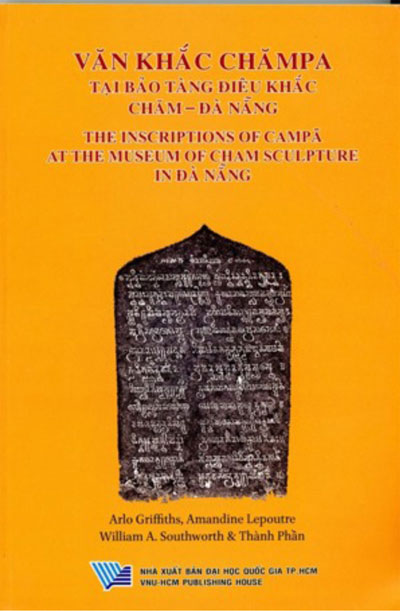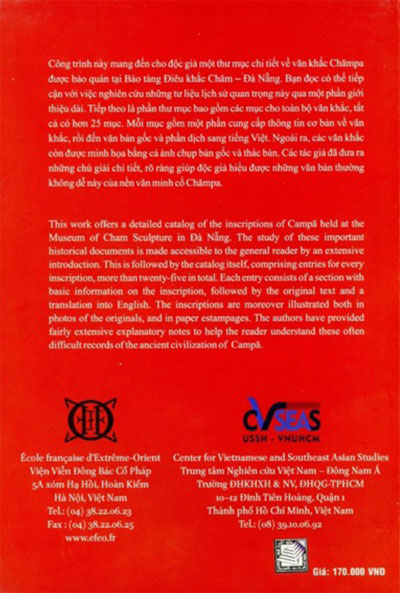The Inscriptions of Campa at the Museum of Cham Sculpture in Da Nang, by Arlo Griffiths, Amandine Lepoutre, William A. Southworth & Than Phan
February 2013

This important work, published in a bilingual edition (Vietnamese & English) presents the detailed catalog of sixty six inscriptions and fragments from Campa, which belong to the Museum of Cham Sculpture in Dà Nang. This research is part of a project of Ecole Française d’Extrême Orient establishing Ancient Campa corpus of inscriptions.
The Vietnamese text, written by M. Nguyen Thanh Xuan, covers one hundred thirty two pages illustrated with thirty eight photos. The text in English follows with twenty black and white photos of paper stampings. All, except three of them, were already listed. Essentially, these inscriptions come from five provinces, from the northern province of Quang Bin to the mountain site of Yang Mum. It is important to note that there is not an inscription at the Dà Nang Museum coming from the Quang Tri province.
These inscriptions were the result of incidental discoveries. In this catalog, they are not listed in a chronological order or by site, but according to their inventory number, from C 43 to C 236, which most often, matches their discovery order.
An extensive introduction summarizes the history of Campa epigraphic studies. Comments on the Museum history and its epigraphic collections are then followed by an inventory of materials used for inscriptions (most often sandstone, also granite and terra cotta), a linguistic analysis, an outline of paleographic evolution and the content of these texts. However, the presentation does not make
mention of the probable loss of Museum’s archives.
After a short bibliography, an introduction is followed in both languages by twenty entries (fragments being occasionally compiled); some explanatory notes are extremely detailed. As an example, stele C 43 from Drang Lai, which is dated second quarter of 15th century AD, or inscription C 150 from Ron, of which the authors have doubts about its buddhist use, though not giving a conclusion. Some inscriptions, at least three, are introduced here for the first time.
The chronology of reviewed artifacts range from the 7th century AD, like C 230 (found near the My Son temple E 1) or C 87 ( near My Son B 6), to the 15th century AD, like C 161 (on the backside of a statue of Siva found at Chien Song). However, a chronology based on paleography is still subject to discussion, especially for those usually dated around the 9th and 10th centuries. In our opinion,
further research on the evolution of the Cam written forms could only be made in parallel with those of Mon, Khmer and Indonesian. As for usual dating of other vestiges (sculptures and buildings), they should be extensively reconsidered. This rigorous, extremely detailed research, which is a part of larger inventory project, is one of the new tools making extensive historical and sociological knowledge of Ancient Campa possible.
Emmanuel GUILLON, February 2013 (Translated from French)



 James H.W. Thompson Foundation, Bangkok, Thailand.
James H.W. Thompson Foundation, Bangkok, Thailand.